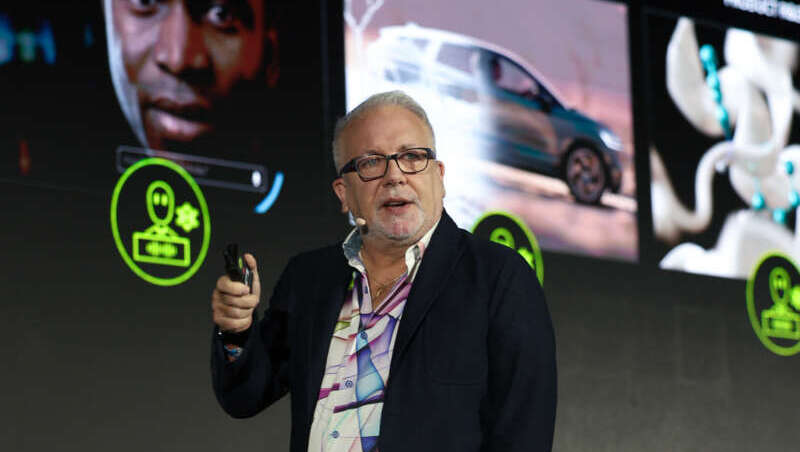
Bob Pette, vice president and general manager-enterprise platforms at NVIDIA, offered a sweeping review of the company’s history in artificial intelligence technology development at the NVIDIA AI Summit on Oct. 8 and unveiled the company’s new NVIDIA NIM Agent Blueprint for container security.
During a special address at the AI Summit, Pette ran down NVIDIA’s work since its founding in 1993 and talked about the historical context of computing transformations, the company’s innovations in AI and GPUs (graphical processing units), development of NVIDIA’s CUDA parallel computing platform, and the company’s focus on generative AI “factory” concepts.
On the public sector front, Pette detailed the company’s ongoing drive into the cybersecurity field – partly through a Q&A with its “James” interactive digital human avatar – who said that “NVIDIA AI is enhancing cybersecurity by accelerating threat detection, improving incident response, and enabling real-time threat analysis.”
The NIM Agent Blueprint for container security, Pette said, is helping industries across the board to safeguard their critical infrastructure with AI-driven assistance that provides security vulnerability analysis and reduces the time to analyze vulnerabilities from days to seconds.
Diving deeper, Pette explained that developers can adapt the solution to meet their own application requirements, preserving software security as software is shipped and installed.
The blueprint takes advantage of NVIDIA NIM microservices, the NVIDIA Morpheus cybersecurity AI framework, NVIDIA cuVS and NVIDIA RAPIDS accelerated data analytics to help speed analysis of common vulnerabilities and exposures at enterprise scale, the company said in a separate product announcement.
“As you deliver software around the world, as we all deliver software around the world, you’ve got to worry about software mismatches … that leave a back door, that leave a vulnerability,” Pette said.
“So, yes, we’re using it for cyber, but it can be used for a software rollout which might create a cyber incident, but also could just create a blue screen” in the event of failure, Pette said.
“This triaging of a software rollout that all companies have to worry about could take hours or days by humans, and this blueprint automates it,” Pette said. He explained that the process takes advantage of four different finely tuned LLMs (large language models) and several NIM microservices – generative AI microservices for accelerating the deployment of foundation models on cloud and data centers.
The process, Pette said, can “take that hours and days down to minutes to ensure that what you’re about to ship is going to work on the target that you’re going to ship to.”
Pette shared that Deloitte has adopted the NVIDIA NIM Agent Blueprint and is incorporating the technology into its’ CyberSphere security service platform.
He said that Deloitte is taking on “agentic analysis for open source software,” and in the process is boosting productivity “by allowing security analysts to focus on the most critical tasks, while AI handles the heavy lifting of analysis, delivering fast and actionable insights.”
“Cybersecurity has emerged as a critical pillar in protecting digital infrastructure in the U.S. and around the world,” commented Mike Morris, managing director at Deloitte & Touche LLP. “By incorporating NVIDIA NIM Agent Blueprint into our cybersecurity solutions, we’re able to offer our clients improved speed and accuracy in identifying and mitigating potential security threats.”
Agentic AI, NVIDIA said, goes beyond traditional AI by enabling intelligent agents to perceive, reason, and act autonomously. “Agentic systems can access tools and reason through full lines of thought to provide instant one-click assessments,” Pette added.
“Cybersecurity is very, very top of mind for the public sector,” Pette said. “We don’t just stop at the NIM level, at the blueprint level, because it is a full stack problem, so we implement network security and hardware.”
Pette explained that NVIDIA implements “run-time security” through its DOCA software platform, which the company says enables developers to create software-defined, cloud-native, accelerated services “with zero trust protection, addressing the performance and security demands of modern data centers.”
“NVIDIA is the only provider to performantly implement confidential computing to protect those LLMs, and that’s the only way of protecting your crown jewels to deliver secure and trustworthy AI,” he said.
“People can try to attack the encryption codes and where data is moving, but I think we all can imagine it’s much easier to read a Word file than it is an encrypted file,” he said. NVIDIA “is the only platform to performantly implement confidential computing in hardware to protect the integrity of LLMs, and we’re working with many partners to implement these zero trust solutions,” Pette said.
To learn more, watch Pette’s entire special address on-demand here.
